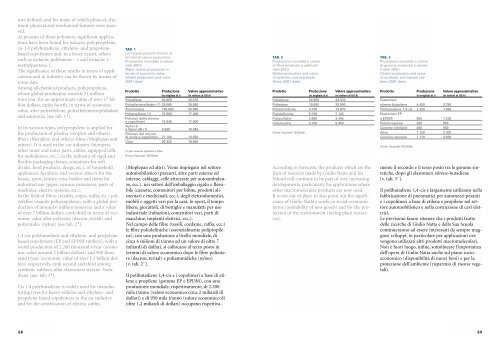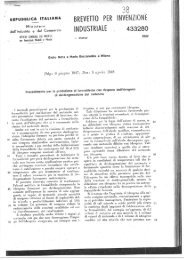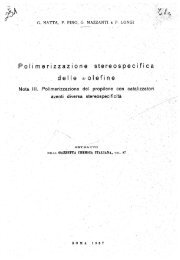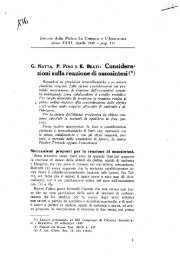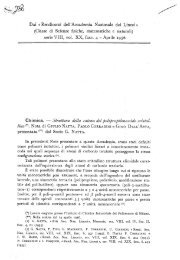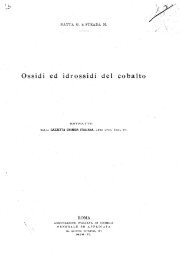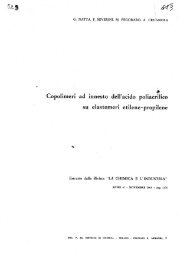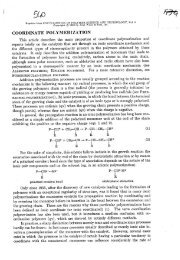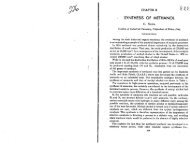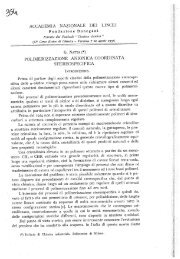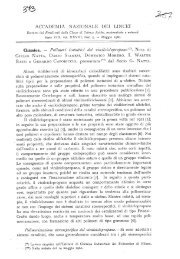n. 7, Ottobre 2003 - Giulio Natta
n. 7, Ottobre 2003 - Giulio Natta
n. 7, Ottobre 2003 - Giulio Natta
Create successful ePaper yourself
Turn your PDF publications into a flip-book with our unique Google optimized e-Paper software.
Il polibutadiene 1,4-cis e i copolimeri a base di etilene<br />
e propilene (gomme EP e EPDM), con una<br />
produzione mondiale, rispettivamente, di 2.200<br />
mila t/anno (valore economico circa 2 miliardi di<br />
dollari) e di 950 mila t/anno (valore economico di<br />
oltre 1,2 miliardi di dollari) occupano rispettivature<br />
defined, and for many of which physical, chemical-physical<br />
and mechanical features were assessed.<br />
At present, of these polymers, significant applications<br />
have been found for isotactic polypropylene,<br />
cis 1.4 polybutadiene, ethylene- and propylenebased<br />
copolymers and, to a lesser extent, others<br />
such as isotactic polybutene - 1 and isotactic 4 -<br />
methylpentene-1.<br />
The significance of these results in terms of applications<br />
and in industry can be shown by means of<br />
some data.<br />
Among all chemical products, polypropylene,<br />
whose global production exceeds 31 million<br />
tons/year, for an approximate value of over 17 billion<br />
dollars, ranks fourth, in terms of economic<br />
value, after polyethylene, polyethyleneterephthalate<br />
and ammonia [see tab. 1 ].<br />
In its various types, polypropylene is applied for<br />
the production of plastics (moplen and others),<br />
fibers (Meraklon and others) films (Moplepan and<br />
others). It is used in the car industry (bumpers,<br />
other inner and outer parts, cables, equipped cells<br />
for ambulances, etc.), in the industry of rigid and<br />
flexible packaging (boxes, containers for soft<br />
drinks, food products, drugs, etc.), of household<br />
appliances, furniture and various objects for the<br />
house, sport, leisure, toys, bottles and items for<br />
industrial use (pipes, various containers, parts of<br />
machines, electric systems, etc.).<br />
In the field of fibres (textiles, ropes, raffia, etc.) polyolefins<br />
(mainly polypropylene), with a global production<br />
of around 6 million tons/year and a value<br />
of over 7 billion dollars, rank third in terms of economic<br />
value after polyester (dacron, terital) and<br />
polyamides (nylon) [see tab. 2 ].<br />
1.4-cis polybutadiene and ethylene- and propylenebased<br />
copolymers (EP and EPDM rubbers), with a<br />
world production of 2,200 thousand t/year (economic<br />
value around 2 billion dollars) and 950 thousand<br />
t/year (economic value of over 1.2 billion dollars)<br />
respectively, rank second and third among<br />
synthetic rubbers, after elastomers styrene -butadiene<br />
[see. tab. 3 ].<br />
Cis 1.4 polybutadiene is widely used for manufacturing<br />
tyres for heavy vehicles and ethylene- and<br />
propylene-based copolymers in the car industry<br />
and for the construction of electric cables.<br />
TAB. 1<br />
I principali prodotti chimici in<br />
termini di valore economico<br />
Produzione mondiale e valore<br />
(dati 2001)<br />
Major chemical products in<br />
terms of economic value<br />
Global production and value<br />
(2001 data)<br />
Prodotto Produzione Valore approssimativo<br />
(in migliaia di t) (in milioni di US $)<br />
Polietilene 52.850 33.470<br />
Polietilentereftalato (1) 29.560 29.560<br />
Ammoniaca 136.000 25.840<br />
Polipropilene (1) 31.600 17.380<br />
Polimeri dello stirene<br />
e copolimeri 19.340 17.000<br />
Nylon 6<br />
e Nylon 66 (1) 5.550 16.845<br />
Polimeri del cloruro<br />
di vinile e copolimeri 27.100 13.550<br />
Urea 60.325 10.850<br />
(1) per materie plastiche e fibre<br />
(Fonte: Parpinelli TECNON)<br />
(Moplepan ed altri). Viene impiegato nel settore<br />
automobilistico (paraurti, altre parti esterne ed<br />
interne, cablaggi, celle attrezzate per autoambulanze,<br />
ecc.), nei settori dell'imballaggio rigido e flessibile<br />
(cassette, contenitori per bibite, prodotti alimentari<br />
e medicinali, ecc.), degli elettrodomestici,<br />
mobili e oggetti vari per la casa, lo sport, il tempo<br />
libero, giocattoli, di bottiglie e manufatti per uso<br />
industriale (tubazioni, contenitori vari, parti di<br />
macchine, impianti elettrici, ecc.).<br />
Nel campo delle fibre (tessili, cordame, raffia, ecc.)<br />
le fibre poliolefiniche (essenzialmente polipropilene),<br />
con una produzione a livello mondiale, di<br />
circa 6 milioni di t/anno ed un valore di oltre 7<br />
miliardi di dollari, si collocano al terzo posto in<br />
termini di valore economico dopo le fibre poliestere<br />
(dacron, terital) e poliammidiche (nylon)<br />
[v. tab. 2 ].<br />
TAB. 2<br />
Produzione mondiale e valore<br />
di fibre sintetiche e artificiali<br />
(dati 2001)<br />
Global production and value<br />
of synthetic and manmade<br />
fibres (2001 data)<br />
Prodotto Produzione Valore approssimativo<br />
(in migliaia di t) (in milioni di US $)<br />
Polietilene 52.850 33.470<br />
Poliestere 19.000 20.900<br />
Poliammidiche 3.750 13.875<br />
Poliolefiniche 5.700 7.125<br />
Poliacriliche 2.650 3.445<br />
Cellulosiche 2.700 9.450<br />
(Fonte: Parpinelli TECNON)<br />
According to forecasts, the products which are the<br />
fruit of research made by <strong>Giulio</strong> <strong>Natta</strong> and his<br />
School will continue to be part of ever increasing<br />
developments, particularly for applications where<br />
other macromolecular products are now used.<br />
It is not out of place to also point out the significance<br />
of <strong>Giulio</strong> <strong>Natta</strong>’s works in social-economic<br />
terms (availability of new goods) and for the protection<br />
of the environment (saving plant resources).<br />
TAB. 3<br />
Produzione mondiale e valore<br />
di gomme sintetiche e naturali<br />
(dati 2001)<br />
Global production and value<br />
of synthetic and natural rubbers<br />
(2001 data)<br />
Prodotto Produzione Valore approssimativo<br />
(in migliaia di t) (in milioni di US $)<br />
Elastomeri<br />
stirene-butadiene 4.450 3.785<br />
Polibutadiene 1,4-cis 2.200 1.960<br />
Elastomeri EP<br />
e EPDM 950 1.235<br />
Policloroprene 285 855<br />
Gomme nitriliche 450 900<br />
Altre 1.150 2.300<br />
Gomma naturale 7.170 3.585<br />
(Fonte: Parpinelli TECNON)<br />
mente il secondo e il terzo posto tra le gomme sintetiche,<br />
dopo gli elastomeri stirene-butadiene<br />
[v. tab. 3 ].<br />
Il polibutadiene 1,4-cis è largamente utilizzato nella<br />
fabbricazione di pneumatici per automezzi pesanti<br />
e i copolimeri a base di etilene e propilene nel settore<br />
automobilistico e nella costruzione di cavi elettrici.<br />
Le previsioni fanno ritenere che i prodotti frutto<br />
delle ricerche di <strong>Giulio</strong> <strong>Natta</strong> e della Sua Scuola<br />
continueranno ad essere interessati da sempre maggiori<br />
sviluppi, in particolare per applicazioni ove<br />
vengono utilizzati altri prodotti macromolecolari.<br />
Non è fuori luogo, infine, sottolineare l'importanza<br />
dell'opera di <strong>Giulio</strong> <strong>Natta</strong> anche sul piano socioeconomico<br />
(disponibilità di nuovi beni) e per la<br />
protezione dell'ambiente (risparmio di risorse vegetali).<br />
68<br />
69


